“In all the world, no rarer treat than the lantern light of Bittersweet.”
As much a symbol of autumn in America as pumpkins and indian corn, American Bittersweet is in need of caring stewards who will offer it a home and salvation. Rather than search high and low for it in the wild, make a place for it on your own homestead. In doing so, you’ll help save an endangered native species.
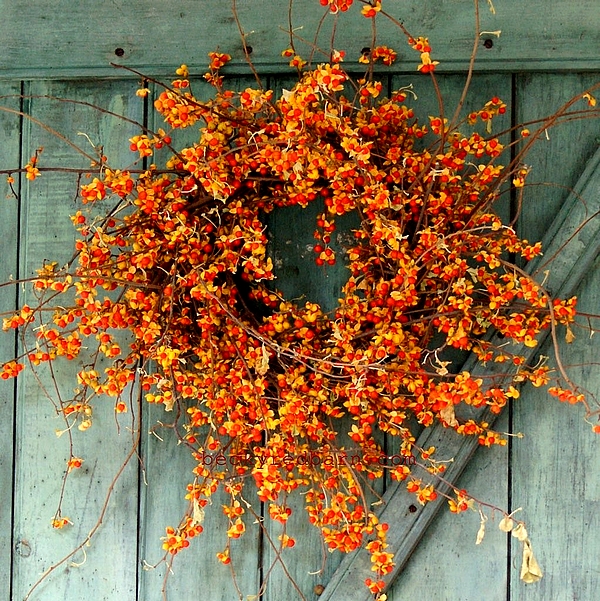
Above: A wreath of freshly harvested American Bittersweet; photo courtesy of beckyredbarn.com
This lovely perennial vine, covered with tiny lantern like pendants was given the name Bittersweet by European colonists in the 18th century because the fruits resembled the appearance of the fruits of Eurasian Nightshade. The American Bittersweet vine is now a protected species. Sadly, it is confused with a highly invasive version, Oriental Bittersweet, that chokes trees and makes a tangled pest of itself in some parts of the country. It is considered to be one of the most invasive “weeds”. On the other hand, American Bittersweet is not invasive … no, in fact, it can be rather elusive. Because it does resemble the undesirable species, it is often mistaken for it and eagerly eradicated. To tell these two apart is actually quite easy: the good kind bears husked fruit in little clusters on their own little branches toward the ends of the main vine – kind of like grapes. Plain red berries grow along the vine stem on the bad kind. The below photo and all other photos in this article are of American Bittersweet.
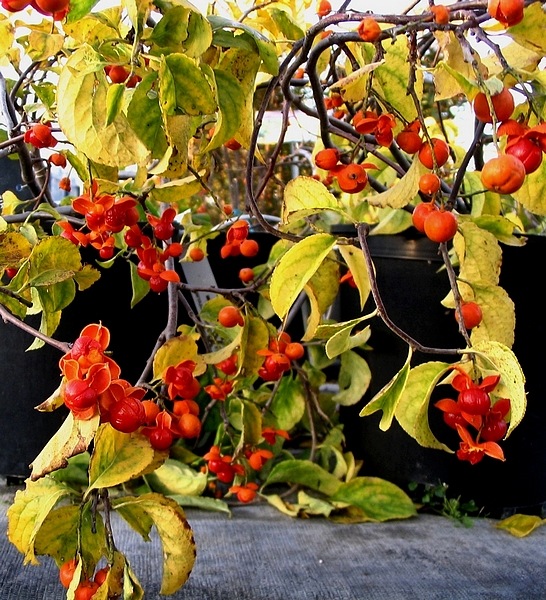
During the autumn season the female vines put on a display few other plants can rival, as the mustard yellow skins of the berries (the “husk”) bursts to reveal a deep orange jewel within. Not to be outdone by the berry, the plant’s fall foliage drapes fences and trees that is grows upon in a blanket of brilliant yellow leaves.
American Bittersweet is found mostly in rich, well drained soil that gets a fair amount of moisture. It can be seen growing on fences next to ditches along woodland country roads where it gets more water from drainage. It will also attach itself to trees for support. The vine blooms during the month of June. The berries that develop are toxic to humans, but birds and other small aniamls eat them eagerly.
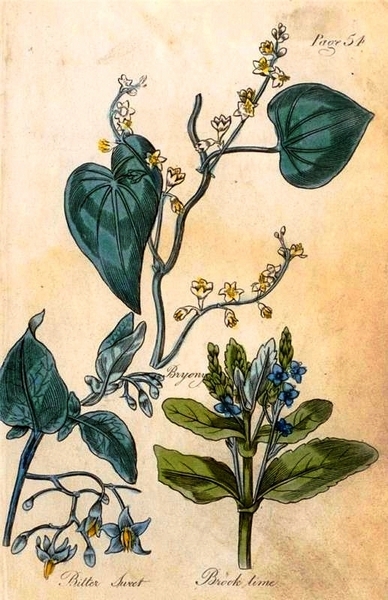
While oriental bittersweet vines are considered an environmental menace by many, American bittersweet is becoming so rare in some areas that it is now a protected species. Oriental bittersweet wraps itself around and eventually kills trees; while American bittersweet plants are themselves threatened.
In fact, oriental bittersweet vines have spread so successfully that they are beginning to displace their native rival, according to Conservation New England, which lists these reasons that account for why it out-competes its American relative: It is more enticing to birds (which, in turn, disperse the seeds after eating the berries), because its berries are a brighter red color (it also produces more berries) … and the seeds germinate at a higher rate.
So, how does the destructive bittersweet work? It can be difficult to imagine a vine killing a tree, but oriental bittersweet vines have slain many a giant … and they kill small trees easily. Capable of reaching four inches in diameter, oriental bittersweet vines wrap so tightly around their victims that the trees are strangled, in a process called girdling. YesSireeBob, do not give the killer vine any mercy! But, American Bittersweet is a lovely addition to your farmgirl landscape plan. It is neither destructive nor invasive.
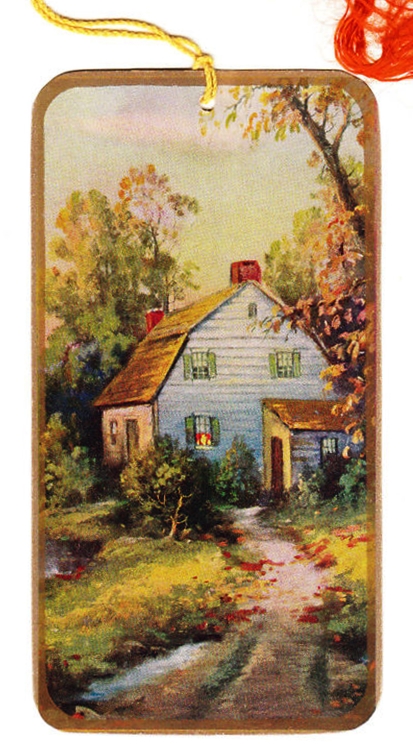
The American Bittersweet plant is also referred to as ‘false bittersweet.’ So, is there a ‘true bittersweet’?” The answer is yes, but true bittersweet is not represented by the oriental type either. To cover all the bases in regards to the three kinds of bittersweet, we have to introduce a third plant into the conversation. True bittersweet, “Bittersweet Nightshade”, is distinctly different from oriental bittersweet and our native bittersweet. Beginning as a green berry, the fruit of this bittersweet plant changes first to yellow, then orange, and finally red. Not all the berries reach these color stages at the same time. Consequently, it is not uncommon to see a bittersweet nightshade plant bearing berries of three or four different colors.
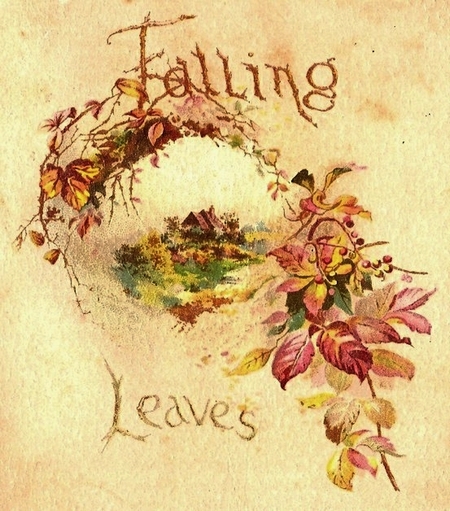
The berries of bittersweet are toxic. While not extremely so, they will ‘clean you out at both ends’. Nuff said! Ever wonder how bittersweet earned the name. The King’s American Dispensatory has the following to say about the twigs of bittersweet: “their taste is bitter, followed by acrid sweetness.” Now you know. So, look … but don’t eat!
~ Bittersweet ~
Before the reign of falling snows, with Bittersweet the valleys glow,
Oak trees locked in its embrace enchant each lonely forest place,
Gray branches fringed with orange flames put other woodland sights to shame;
Their beauty does not dare compete with crimson flame of bittersweet.
In secret glens burn autumn pyres of kindled bittersweet on fire;
Its clinging vines entice, caress great oaks with tenderness,
And country folk delight to see the beauty of each lovely tree …
In all the world no rarer treat than the lantern light of bittersweet.
~ Brian King
Aside from American Bittersweet adding texture and colorful beauty to a country-style home, it also attracts hungry birds. If you don’t harvest the vines, your feathered friends will feast on the vivid orange berries.
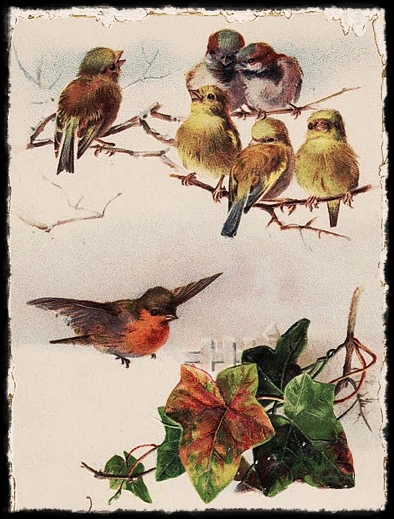
So, have you a place for American Bittersweet? There are numerous sources of information online that will tell you how best to nurture this lovely vine. You can also purchase plants online … as well as freshly harvested decorative vines and ready-made wreaths. I also noticed many pots of it at my favorite greenhouse. You need at least two plants (male & female). Here are some leads for you to explore:
Growing American Bittersweet: http://www.extension.umn.edu/yardandgarden/ygbriefs/h400bittersweet.html
To buy fresh vines and wreaths, try eBay! I bought mine there. Also, go to http://silverymoonfarm.com/seasonal.html – they offer fresh wreaths.
If you think you need some bittersweet for your fall decorating, you better place your order NOW. It sells out quickly and it is only available for a short time. Next spring, I’m going to buy a couple of pots of American Bittersweet and give them a try. I don’t have ideal condtions for bittersweet, but, I can insure that they’ll get enough water in my garden-yard (by the fence), plus a place to climb and cling to. Perhaps you have the kind of place that this vine prefers. If so, lucky you!
If you have MaryJane’s books, you might have noticed her vintage “Jewel Tea” dishes. The decoration on the dishes is bittersweet. The dishes in the photos were her mother’s. Many women collected Jewel Tea ‘back in the day’ … and still do. The ‘dishes’ come in a vast array of food oriented items and are a hot collectible nowadays – what with fresh interest in vintage & retro. I recently spied a vintage one-gallon thermos jug wearing a price of over $100.
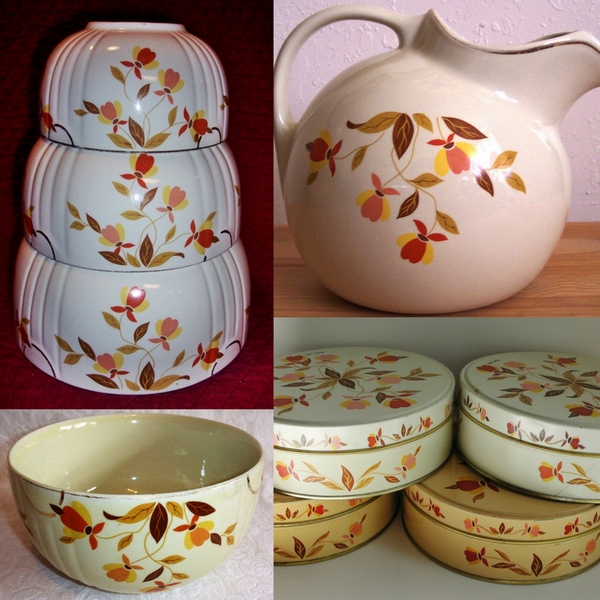
A dear friend of mine has hundreds of pieces of Jewel Tea, given to her by her MIL. They are the ‘holiday dishes’ … used for large family gatherings because she has piles of place settings and every service piece known to mankind 🙂 No doubt, the set will someday be split up between her two sons and their wives.
Bittersweet has long been a beloved harbinger of Autumn for me, even more so than all the other harvest beauties. Years back, my sister (Beth) and I harvested bittersweet in the wild (before it was protected). It grew plentifully in the Black Hills of South Dakota where we lived. She and I would take to the back-roads and make wreaths on-site as we harvested the vines (usually from off of road-side fences). We pardnered up and sold all kinds of wreaths at a large bazaar just after Thanksgiving. We also made and sold home-made potpourri. Here is a blast from my past … my baby sister and I in the early 1980s when we were both armpit deep in the arts & crafts business. I’m the coffee-bean brunette.

As you might imagine, the bittersweet wreaths that we made were the first to sell. I carefully boxed mine for as many years as they would ‘hold up’. The wreaths dry and the berries fall off easily (by design). So, know this: don’t hang your wreath on a door that moves … like your front door. It will not last long there – first the husks, then the berries will fall off. Hang it where it is still. When autumn has passed, box the wreath in a container that won’t allow it to slide around. Store it in a place away from activity. If these guidelines are followed, your wreath will last several years if need be. If you live in a place where bittersweet is readily available, you can get a fresh wreath every year and put the old one out for birdfood.
I love autumn … ‘jacket weather’ season! There is nothing more fun than foraging in the country this time of year <in my opinion>. An arm-full of dried grass makes a wonderful fall arrangement – stood up in an antique crock or ice cream bucket. Or, how about saving those pruned tree branches for the same crock if tall grass isn’t available. And, if you add a wreath of bittersweet to the room, you’ll have a feast for the eyes while you sip on a cup of steamy cider. MmMmmm … Enjoy the sweetest of seasons!
“Across the meadow, through the shadows, I walk to drink of autumn’s wine; The charm of story, the artist’s glory, today on these frosty hills is mine.”
~ Lucy Maud Montgomery
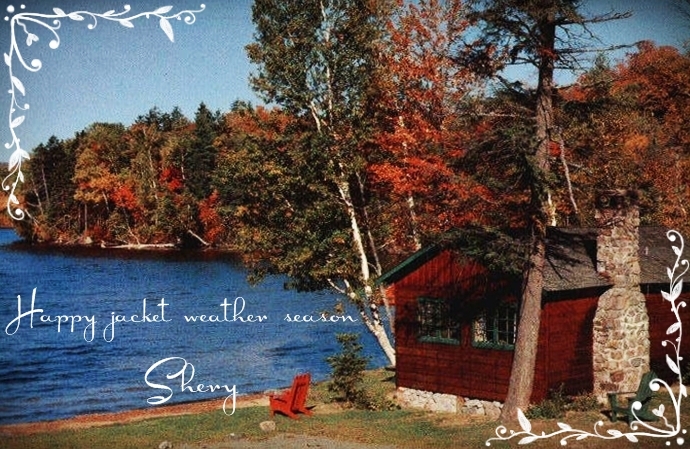






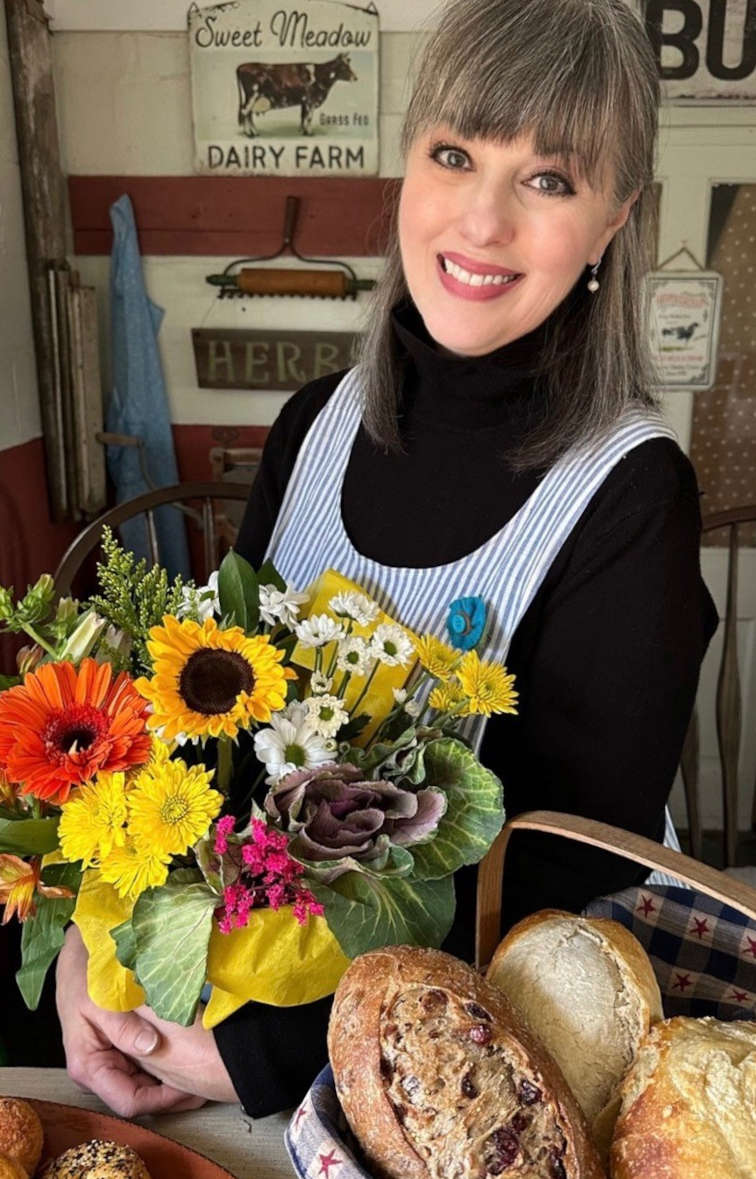




Thank you, Shery for the Bittersweet information. Just the other day I was saying how I wanted more Fall colors in my gardens – I have a front porch railing that NEEDS some interest and I wouldn’t have to cut it to use it – going to look into that for sure. As always a great time was had while you shared yourself. God Bless
Great information! Thanks so much. I have two true bittersweets that I nurture all year so I can add those lovely branches to my fall arrangements. Again, thanks for the information.
Hello!
This vine is surely a beauty! What a beautiful fall addition to ones own beloved garden, looks like I am going to have to find a resource so I can plant a "couple" in my own garden!
Thanks for the sharing !
Truly,
Colette
This is wonderful information! If anyone finds out where we can get seeds from please let me know, I would love to plant this, I have creeks and brush winding through my property in BC , and it will make such lovely wreaths! Too bad we couldnt locate seeds and share some amoungst us farmgirl sisters! I will see what I can find…
Thank you~
Ang
Shery: We have American Bittersweet in our back yard against the fence. We were in a drought this summer and we had about 6 berries. But when it does produce, it is really beautiful. Also I think of autumn when my chinese lanterns bloom. If you would like some I have lots of seeds to share. Thanks for the beautiful pictures.
———
Hi Bonnie! Oh you lucky goil … … to have chinese lanterns! I love them. I planted seeds this past spring, but I didn’t get anything 🙁 Is there a secret to them?? Shery
Great information and thanks for sharing it Shery! I always love to read your blog!
Smiles, Cyndi
Hi Shery, Your bittersweet wreaths are sooo pretty! Thanks for all of the information! Fall is my favorite time of the year, sure wish it would last longer. What a pretty picture of you and your little sis. BTW I just looked at your last post and loved all of the beautiful pictures. Your Ribbon is quite a beauty!
I always look forward to you posts!
Happy Fall!!
———-
Thanks Jan for stopping by and for the kind comments 🙂
Shery,
I live in California, can I grow Bittersweet here?
I am from Germany, and when I saw the pictures, it reminds me of home, kinder, gentler good old days, with parents and grandparents, now long gone – but never far away, in my heart.
I do want to grow this plant. Thanks so much for your blog, and for sharing.
Ursula
———
Hi Ursula, I don’t know, but, all the info I came across claims that it is easy to grow. It does like moisture and decent soil…neither of which I can provide naturally. That is why I’m going to plant it along my garden fence and hope for the best. Shery
Thank you Sherry for identifying the true Bittersweet for me! We found some near our property the other day, and the multi-colored berries were so lovely. My son almost ate them, but I reminded him that the rule for foraging is if we don’t know what it is, we couldn’t eat it. So thanks! Now we know!
What a fabulous article. I want to grow American Bittersweet but do not know how to obtain seeds or the plants. Can you help me?
Sandy Patzman
Lakeville, Minnesota 55044
sandypatzman@frontier.com